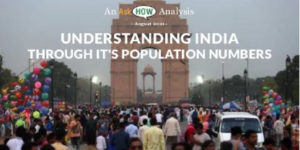Why does the myth of low government salaries persist?featured
Edit: I have added a small section ‘Why does it matter?’ towards the end based on a few comments I recieved.
Don’t think badly of me but I am the kind of person who gets into discussions on social media! Many of these discussions are on the performance of governments in India. There are people who argue that the bad performance is due to the ‘low salary’ paid by government — a version of the ‘pay peanuts, get monkeys’ argument. I am not very surprised by this as a few years ago, I too believed that government employees get a low salary. In this post I will try to explain why this belief persists in some people.

But first, aren’t salaries in government low?
Are government salaries low?
In 2015, the Indian Institute of Management, Ahmedabad (IIMA) compared salaries across government and private sector. Here are some of the highlights from their detailed report.
1. The salary in government was higher or similar to the salary in private sector for 35 of the 37 categories that IIMA looked at.
2. In many of these 35 categories the government salaries were much higher. So much so that a professional with 15 to 25 years of experience in a private company would get a lower salary than the starting salary in government! Examples of such professions included physiotherapists, lab technicians, teachers, draftsmen and gardeners.
3. In many professions, private sector jobs were in two kinds of organizations. The salaries in the first type were comparable to government salaries but were much lower in the second type. School education is a good example of this phenomenon. Some private schools are prestigious and may well pay salaries comparable to the salaries in government sector. However, most private schools pay their teachers and staff much lesser money than what the government pays.
4. In a few jobs the salaries in the private sector were much lower to start with, but caught up in a decade or so. These were jobs where skills were required and either there was a lot of demand for experienced professionals or the supply was restricted. A good example would be nursing. The starting salaries for nurses in government sector was more than thirty-seven thousand whereas in private sector it was between thirteen and seventeen thousand. For professionals with 25 years of experience the salary went up to ninety thousand for both.
5. The starting salaries in some private jobs were really low. Especially, when compared to starting salaries in any government job. For example, the starting salary for scientists in the private sector was between thirteen and eighteen thousand. Whereas, the starting salary for drivers in government jobs — where the qualification requirement was only matriculation — was around twenty-five thousand!
6. The only two categories where the private sector salaries were higher were Doctors with MD / MS and in accounting services. It must be noted here that for doctors with MBBS, the salaries in private sector were lower. Even in accounting services, only some companies paid some professionals a high salary. The salaries for other accounting professionals were much lower.
As far as I could make out, the qualification requirement for private sector jobs was the same as comparable government job and in some cases, it was even higher!
The IIMA report looked at “fixed pay, variable pay, allowances and benefits, and employers’ contribution” while making comparisons. Non-cash benefits were not included. One of the biggest benefits of a government job — job security — is an example of non-cash benefit. Covid-19 demonstrated the value of this benefit. Many private companies fired their employees or reduced their salaries when the pandemic hit their revenues. This was not a risk you had to face if you were a government employee.
Another non cash benefit of a government job is status. This is a point made even by the Seventh Pay Commission.
“It may be observed at the outset that government service is not merely a contract service, it provides a status in society which cannot be monetised in terms of money value (sic).”
The IIMA study compared mainly category B and C jobs in government sector with similar jobs in private sector. As per the Seventh Pay Commission report, Class B and C employees are more than 97% of government total strength.
As I have shown, in most cases government jobs paid much more than private sector jobs. However, comparing government and private sector jobs is only half the story as most Indians do not even have a regular salary paying job.
Employment does not mean regular salaried work.
In India, only 48% of people with any kind of employment, had regular salaried jobs in the quarter October — December 2019 [1]. This is when the Labor force Participation rate in the same quarter was as low as 37% (57% for male and 17% for female). In other words, more than 60% of working age people were not looking for employment and of those employed, only 48% had regular salaried employment.
We have extensively covered the difference between Naukri (job) and kaam (work) in our piece on employment. The 52% not in regular salaried employment were either employed in their own enterprises or were casual laborers. It is known that most of these enterprises are very small businesses such as vegetable carts and these businesses do not make much money. Most of the people who work as casual laborers or in own enterprises would switch to a regular government job or even a private job if they could get it.
To summarize, most government jobs pay much more than private jobs. Furthermore, these come with job security and a high status. Additionally, a regular wage paying job is not the norm for working age people in India. Casual labor or work in own enterprise pays much lesser than even a private job. Then why do some people still believe that government salaries are low? I could think of three reasons why it may be so. The first reason is that they may be thinking of state government jobs when they think of government jobs.
Do state government jobs have a low pay?
The comparisons that I have made above are for central government jobs. It is beyond the scope of this post to compare salaries of all state government employees with salaries in private sector, but I note two things.
First, many state governments link their salary levels to that in central government. Here is Seventh Pay commission again
“It is clear from the study that a significant number of States follow the recommendations of the Central Pay Commission. Equally, there is significant plurality of States that design their own pay awards based on the recommendations of their own State Pay Commissions, which of course do consider the recommendations the Central Pay Commission and subsequent Government of India award.”
It is my belief that relatively poorer states are the ones which do not base their pay on Central Pay Commission. Hence, the salary levels even in private sector there would be lower than in richer states. The government finances of such states also may not be robust enough to have a pay scale similar to that in central government.
The second thing to note is that many news reports make it clear that most citizens prefer government jobs to any other employment. This desire for government jobs is reflected in the applications that governments get in response to advertisements. For example, this story states that the UP government received applications from 3,700 PHDs holders, 50,000 graduates and 28,000 PGs for 62 posts of messengers in UP police. The post had a minimum eligibility of Class V.
Based on the two factors mentioned, I believe that it is likely that most state government jobs in the country pay higher salary than most private jobs.
Let us look at the second possible reason for the persistence of myth of low salaries: the association of bad performance with low salary.
Does bad service performance by state government lead to the myth of low salaries?
It is possible that people reflexively associate bad service delivery with low pay. So, if they see pictures of shabby government schools or hear about bad educational outcomes, they automatically assume that the employees in those schools must be paid badly.
A related belief that I encounter goes something like this. Yes, government salaries are more than private sector salaries but given the importance of certain jobs, the salaries should be even more. For example, policemen and women should be paid highly so that they have no reason to become corrupt. Or that senior IAS officers make crucial decisions that impact large parts of the country and they should be compensated accordingly.
I have some sympathy for the view. I have seen administrative officers tackle extraordinarily complex challenges, many times working in very adverse conditions. However, I should note here that it is very difficult to discriminate performance amongst government employees and governments cannot pay every employee a much higher salary. There simply isn’t enough money. The wage and pension bill of central and state governments is already very high and many of them get a lot of their work done from contract employees to save on their employee costs! Many states for example, employ school teachers on contract.
I think that the possibly lower state government salary and association of bad service delivery with low pay are not the main reason for the persistence of myth of low government salaries. The main reason is the Pareto Principle and the availability heuristic.
The Pareto Principle and the availability heuristic
I have performed professionally as an Improv theatre artist in Mumbai for the last ten years. One of the privileges of this job is working with highly talented actors. One of the sorrows has been to see how much these talented actors have to struggle financially. This is true for most actors. Mumbai is flooded with talented people from across the world trying to catch a break and most of these people make very little money. And yet, in the general perception, actors are rich people. This is because people associate acting with superstars like Ranveer Singh and Priyanka Chopra. But for every Ranveer Singh there are hundreds of extremely able actors, who have to do all kinds of odd jobs to make ends meet. A very small proportion of actors enjoy a very large share of the revenue that all actors make. This small proportion is very visible because media talks about them all the time. This visibility makes us believe that the very highly paid actors are representative of the whole acting community. This is the Pareto Principle and availability heuristic in action. I believe that these shape our perception of the private sector jobs too.
We hear of the very high remuneration levels of CXOs in large companies or even the starting salaries for great programmers in Googles and Amazons and believe that it is representative of salaries in private sector in general. We compare these salaries with salaries in government sector and believe that they are low. This comparison becomes particularly stark when we consider the highest salaries in government and in private sector. The salary of the Cabinet Secretary of India would be beaten by that of hundreds if not thousands in the private sector. This could also be true for many other administrative services employees (IAS, IPS, IRS and IFS) of the government.
My father was a professor in a university and his pay scale was linked to government salaries. We never discussed salaries at home but I had vague impression that his salary was low. This is possibly because in my mind, I compared it with what a few business people made and with what I read about pay of corporate employee. The vast majority of the country that made much lesser money never entered my consciousness! However, once I became aware of the low-income levels in the country, there was no way to unsee it.
Why does this matter?
If some people think that government pay is low and they are wrong, how does it matter? Especially, as the majority of Indians, who think that a government job is the best option for themselves, do not think so.
It matters because the people who think that government pay is low are well educated folk who earn a lot. Their voices carry more weight than the voice of others. Also, a lot of international and national analysis on performance of governments starts with low pay as a cause. Such thinking is detrimental to figuring out the real reasons for suboptimal service delivery. A more effective government is critical for the development of the country and we should know what causes bad service delivery and what doesn’t. I hope to write more about this in future.
Summary
1. Salaries for most central government jobs are higher than comparable jobs in private sector.
2. It is very likely that salaries for state government jobs are higher than private sector jobs too.
3. Some people believe that salaries in government jobs are low probably because they associate bad performance with low salary. It is also possible that they believe that people performing crucial roles in society deserve more.
4. However, the most likely reason for the persistence of the myth of low government salaries is the Pareto distribution of jobs in private sector and the Availability heuristic. A very small share of private sector jobs pays extremely highly and such jobs get disproportionate attention, making some of us believe that those jobs are representative of all private sector jobs.
[1] I have used the pre-pandemic quarter to avoid any short-term distortions. Although the scale of the figures I am citing is not very different post pandemic also.
Thanks to Manjari for helping me understand this issue more and to Sandeep for pointing me towards IIMA report. As always, errors are all mine.
Author –
Yogesh Upadhyaya
(Yogesh Upadhyaya is one of the founders of AskHow India. Blogs are personal views.)
You can follow AskHow India (@AskHowIndia) or me (@YogeshUpadh) on twitter or me on LinkedIn or Medium. DM me if you wish me to put you on WhatsApp distribution list.



